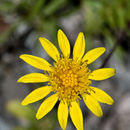Comments
(
Inglês
)
fornecido por eFloras
Pectis longipes has been listed from Texas in floras; I have seen no collections from that state.
Pectis longipes comprises two cytological races. Diploid, spicy-scented plants occur throughout the range. In southern Arizona, the diploid race is broadly sympatric but locally allopatric with a tetraploid, lemon-scented race. The tetraploid race is nested within the range of the diploids. The races are easily separable by odor, and although they are very similar morphologically, they can be separated also by statistically significant differences in floral dimensions and pollen size (M. A. Luckow 1983). Based upon those minute differences, the type collection is diploid. Because the races are so similar morphologically and because so many of the specimens of P. longipes in herbaria bear no indication of odor, I chose not to give the cytological races formal recognition.
- licença
- cc-by-nc-sa-3.0
- direitos autorais
- Missouri Botanical Garden, 4344 Shaw Boulevard, St. Louis, MO, 63110 USA
Description
(
Inglês
)
fornecido por eFloras
Perennials, 8–25 cm (rhizomes branched, 1–10 mm diam.); herbage lemon-scented or spicy-scented. Stems ascending to erect (very leafy), glabrous. Leaves linear to linear-oblanceolate, 10–55 × 1–3 mm, margins with 1–4 pairs of setae, faces glabrous (conspicuously dotted on margins with round oil-glands 0.3–0.5 mm). Heads borne singly. Peduncles (30–)50–160 mm. Involucres campanulate. Phyllaries distinct, linear, linear-oblanceolate, or linear-elliptic, 5–8 × 0.7–2 mm (dotted with 1–3, swollen, subterminal oil-glands 0.3–0.4 mm plus 1–3 pairs of narrow, submarginal oil-glands). Ray florets (8–)13(–15); corollas 8–12 mm. Disc florets 25–50; corollas 4–6 mm (2-lipped). Cypselae 2.5–4.5 mm, strigillose (hairs tips acute or blunt); ray pappi of 1–2 awns 3–3.5 mm; disc pappi of 2–30 unequal bristles 3–5 mm. 2n = 24, 48.
- licença
- cc-by-nc-sa-3.0
- direitos autorais
- Missouri Botanical Garden, 4344 Shaw Boulevard, St. Louis, MO, 63110 USA
Comprehensive Description
(
Inglês
)
fornecido por North American Flora
Pectis longipes A. Gray, PI. Wright. 2: 69. 1853
A perennial, with a cespitose slender caudex; stem densely leafy below, 1-2 dm. high, glabrous, ascending; leaves linear, mucronate, thickish, 2-4 cm. long, 1.5-3 mm. wide, with 2-3 pairs of bristles near the base; glands conspicuous, in a single row along each margin; heads solitary at the ends of the branches or in the upper axils; peduncles 6-14 cm. long, slender; involucre campanulate-turbinate, 6-8 mm. high, 8-10 mm. broad; bracts 12-15, linear, plane above, keeled below, acute, bearing a large apical gland; ray-flowers 12-15; ligules yellow, narrowly oblong, 6-8 mm. long, 1.5-2 mm. wide; disk-flowers 40-75; corollas 4-5 mm. long; achenes 4-5 mm long, more or less pubescent-; pappus-bristles of the disk-flowers 20-40, very unequal, capillary, scabrous, the longest 4—6 mm. long; those of the ray-flowers 2, slender, 3-5 mm. long, and rarely a few additional reduced ones.
Type locality: Mountain valley between San Pedrq and Santa Cruz, Sonera. Distkibution: Western Texas to Arizona, Sonora, Durango, and Chihuahua.
- citação bibliográfica
- Per Axel Rydberg. 1916. (CARDUALES); CARDUACEAE; TAGETEAE, ANTHEMIDEAE. North American flora. vol 34(3). New York Botanical Garden, New York, NY
Pectis longipes
(
Inglês
)
fornecido por wikipedia EN
- licença
- cc-by-sa-3.0
- direitos autorais
- Wikipedia authors and editors
Pectis longipes: Brief Summary
(
Inglês
)
fornecido por wikipedia EN
Pectis longipes, the longstalk cinchweed, is a summer blooming perennial plant and is a genus of pectis. Its floral region is in the US states of Arizona and New Mexico.
- licença
- cc-by-sa-3.0
- direitos autorais
- Wikipedia authors and editors

